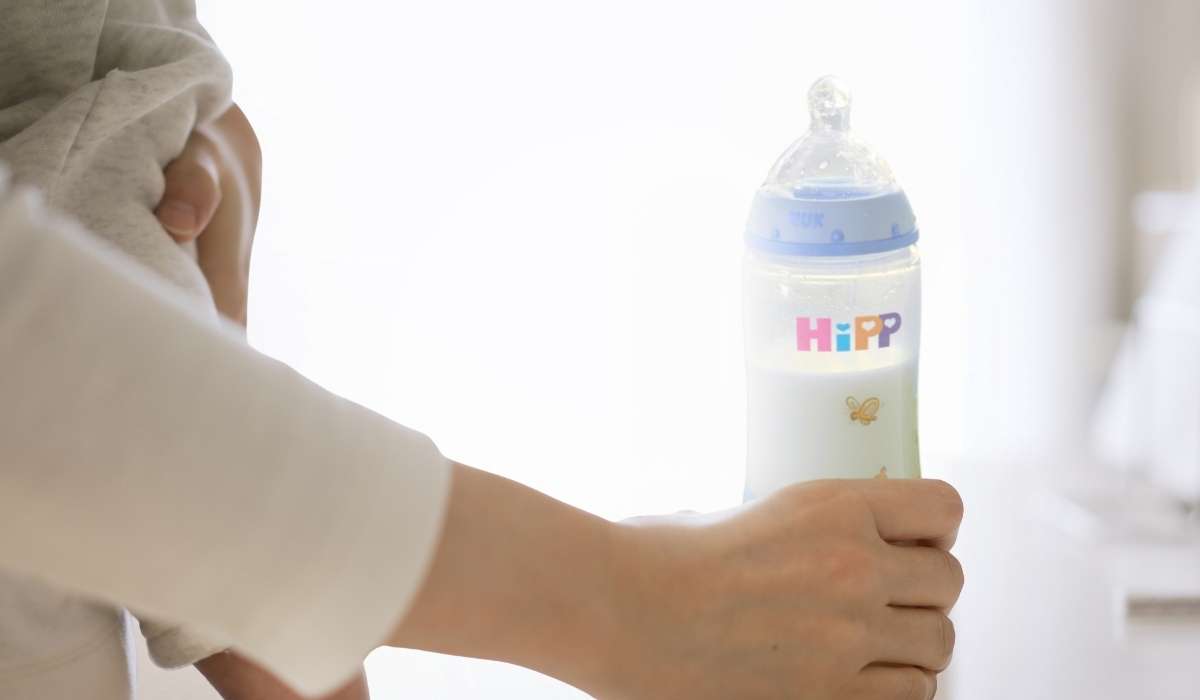When it comes to feeding your little one, things don't always go according to plan. While breast milk is the optimal source of nutrition for babies, the reality is that some mums struggle to produce enough breast milk, others may find breastfeeding extremely challenging, and in rare cases, some have health issues that prevent them from breastfeeding altogether.
When exclusive breastfeeding is not an option, supplemental feeding with baby formula can help fill nutritional gaps in your baby's diet. So, to all you parents out there on the journey of finding the best formula for your breastfed babies, look no further!
Today's guide will help you choose the most suitable option for your little one with the aim of providing them with a formula most like breast milk. We will look at the best baby formulas that are the closest to breast milk, compare their pros and cons, and share some insights about your baby's nutrition!
Contents
- Top 5 - Best Infant Formulas That Are Close to Breast Milk
- Comparison of Top 5 Formulas Similar to Breast Milk
- Understanding Infant Formula and Breast Milk Composition
- How to Choose the Best Baby Formula to Mix with Breast Milk
- How to Introduce Formula to Your Breastfed Baby
- FAQs About The Best Formula For Breastfed Babies
- Wrapping Up: Final Words on Selecting the Best Formula for Breastfed Babies
Top 5 - Best Infant Formulas That Are Close to Breast Milk
The following formulas are crafted to ensure their recipes are as close to human milk as possible, making them some of the best formula for breastfed babies. Let's take a closer look at what these formulas have to offer your baby!
#1 Holle Cow A2 Milk Stage 2: Extra Gentle and Similar Milk Proteins to Breast Milk
With its high digestibility, Holle A2 provides a nourishing choice to support your little one's comfort. This formula is designed to be well-tolerated, particularly by babies with sensitive digestive systems, while not compromising on the familiar taste of traditional cow's milk formula!
A2 milk formula is not considered a suitable alternative for babies with cow’s milk protein allergy (CMPA) or lactose intolerance.
Pros ➕
-
EU-certified organic baby formula
-
A2 cow skim milk is easier to digest
-
No artificial sweeteners, flavors, GMOs, or preservatives
-
Contains ARA (Omega-6) & DHA (Omega-3) for brain and eye development
-
Planted-based DHA obtained from algae instead of fish oil
-
Gluten, soy, and corn syrup free
Cons ➖
-
Has palm oil
-
Stages 2 and 3 contain maltodextrin and starch
Baby Formula Stages Available on Baby Milk Bar 🍼
Holle® (Bio) A2 - Infant Milk Formula - Stage 1 (0-6 months)
Holle® (Bio) A2 - Infant Milk Formula - Stage 2 (6-12 months)
Holle® (Bio) A2 - Infant Milk Formula - Stage 3 (12+ months)
#2 Jovie Stage 2: The Organic Goat Milk Choice for Breastfed Babies
Jovie Goat's powdered formulas are based on organic whole goat milk, mimicking the richness of breast milk closely while being gentle on sensitive tummies. The unique properties of goat milk infant formula, including its high digestibility and natural nutrient content, make Jovie Goat a great choice.
Goat milk formula is not considered a suitable alternative for babies with CMPA or lactose intolerance.
Pros ➕
-
EU-certified organic formula
-
Whole organic goat's milk base
-
A2 goat milk is easier to digest
-
Uses lactose as the main carbohydrate to provide your baby with energy
-
It contains low-allergen milk proteins suited for infants with sensitivities
-
Does not use palm oil or corn syrup
-
Contains DHA (Omega-3) & AA (Omega-6) for brain and eye development
Cons ➖
-
Uses fish oil
Baby Formula Stages Available on Baby Milk Bar 🍼
Jovie® - First Infant Goat Milk Formula - Stage 1(0-6 months)
Jovie® - Goat Milk Formula - Stage 2(6-12 months)
Jovie® - Goat Milk Formula - Stage 3 (12+ months)
#3 Holle Cow German Stage 2: A Standard Transition From Breast Milk
Holle organic cow's milk formula serves as the perfect nourishment for your baby. Made from EU-certified organic and Demeter biodynamic quality skimmed cow's milk and whey, it mirrors the richness of breast milk, catering to your baby's delicate digestive system. Brimming with high-quality natural ingredients, this formula is minimally processed and strictly controlled to maximize nutritional benefit and safety.
Pros ➕
-
EU organic and Demeter biodynamic
-
No artificial sweeteners, flavors, GMOs, or preservatives
-
Gluten, soy, and corn syrup free
-
Contains DHA (Omega 3) & ARA (Omega 6) for brain and eye development
-
Planted-based DHA obtained from algae instead of fish oil
Cons ➖
-
Contains palm oil
-
Stages 2 to 4 include maltodextrin and starch
Baby Formula Stages Available on Baby Milk Bar 🍼
Holle® (Bio) - Infant Milk Formula - Stage Pre (0-6 months)
Holle® (Bio) - Infant Milk Formula - Stage 1(0-6 months)
Holle® (Bio) - Infant Milk Formula - Stage 2 (6-10 months)
Holle® (Bio) - Baby Milk Formula - Stage 3 (10-12 months)
Holle® (Bio) - Baby Milk Formula - Stage 4 (12+ months)
#4 Lowenzahn Stage 2: Mimicking the Best of Breast Milk
This powdered formula is one of the best options when you want to help your breastfed baby transition to bottle feeding. Lowenzahn contains DHA and ARA fatty acids in a 1:1 ratio to more closely resemble the composition of breast milk.
We also appreciate that Lowenzahn adjusts the whey protein to casein protein ratio of their formula to resemble the compositional changes of breast milk. This provides a gentle formula that supports your baby's developing digestive system.
Pros ➕
-
EU-certified organic formula
-
Contains more DHA (Omega-3) & ARA (Omega-6) than required by law, allowing it to support brain development to the fullest
-
Planted-based DHA obtained from algae instead of fish oil
-
Enriched with prebiotics to support your baby's digestive health
-
No artificial sweeteners, flavors, preservatives, or GMOs
-
Gluten, soy, and corn syrup free
Cons ➖
-
Contains maltodextrin, starch, and palm oil
Baby Formula Stages Available on Baby Milk Bar 🍼
Löwenzahn Organics - Infant Formula - Stage Pre / 1 (0-6 months)
Löwenzahn Organics Formula - Stage 2 (6-12 months)
Löwenzahn Organics Formula - Stage 3 (10+ months)
#5 HiPP HA German Stage 2: A Hypoallergenic Formula Solution
HiPP Hypoallergenic formula (HA) is based on extensively hydrolyzed protein from cow's milk. Therefore, this formula is great for babies who have trouble digesting regular cow's milk-based formulas. Hydrolyzed milk, however, means additional processing, making this formula non-organic. Nonetheless, it's produced according to HiPP's strict quality standards and is GMO-free!
HiPP HA formula also contains probiotic lactic acid cultures, originally sourced from real human milk and prebiotics from lactose. These beneficial ingredients support your baby's digestive system and offer greater immune support.
However, HiPP HA is unsuitable for babies with lactose intolerance and may not be suitable for all babies with diagnosed or suspected CMPA, so please consult your baby’s doctor before trying this product.
Pros ➕
-
Uses only lactose as the main carbohydrate source
-
It doesn't contain artificial sweeteners or GMOs
-
Enriched with prebiotics & probiotics
-
Contains DHA (Omega 3) & ARA (Omega 6) for brain and eye development
-
Uses low-allergen milk proteins suited for babies with sensitivities
Cons ➖
-
Not certified organic
-
Contains palm oil from sustainable sources
-
Contains fish Oil
Baby Formula Stages Available on Baby Milk Bar 🍼
HiPP® Hypoallergenic (HA) - Infant Milk Formula - Stage Pre German Version(0+ months)
HiPP® Hypoallergenic (HA) - Infant Milk Formula - Stage 1 German Version(0+ months)
HiPP® Hypoallergenic (HA) - Baby Milk Formula - Stage 2 German Version(6+ months)
Comparison of Top 5 Formulas Similar to Breast Milk
We know it can be hard to choose the best formula for breastfed babies, so let's compare our top 5 side by side...
As listed above, all of the formulas except HiPP HA are certified organic options based on organic ingredients. Lowenzahn, Jovie, and HiPP HA stand out thanks to their inclusion of prebiotics. Not only does this make them closer to human milk, but it also allows these formulas to aid digestion in babies and for added digestive health support, HiPP HA includes probiotics.
Among these infant formula brands, only Jovie uses whole milk. That means in the formulas based on skimmed milk, some of the missing milk fats are replaced by vegetable oils. At the same time, Jovie is the only goat's milk formula on our list. Both Jovie Goat and Holle Cow A2 provide gentle A2 milk options for your baby's sensitive stomach.
Here is a comparison chart to help you determine what formula is closest to breastmilk and suited to your baby's needs:

Understanding Infant Formula and Breast Milk Composition
The American Academy of Pediatrics (AAP) recommends exclusive breastfeeding for at least the first 6 months of your little one's life. This is because breast milk is packed with everything your baby needs for proper nutrition. Breast milk is also known for containing various bioactive agents that help maintain a healthy gastrointestinal tract and immune system!
But when breastfeeding isn't an option, luckily, there are many types of baby formula designed to mimic some of the nourishing components of breast milk. That being said, it is important to consult your pediatrician beforeyou introduce formula to your little one. Or if you've begun formula feeding already but are looking for better options, consult your doctor before switching formulas.
Here are some key ingredients to look for in the best formula for breastfed babies:
#1 Lactose - The predominate carbohydrate in breast milk
Lactose, the primary carbohydrate in breast milk, is responsible for regulating the use of fats and proteins in the body. Lactose is also an important source of energy for your baby.
#2 A2 Milk Proteins - The same proteins that make up breast milk
Milk is comprised of 2 main types of proteins: A1 and A2 milk beta-casein. Many formulas contain A1 protein. However, breast milk contains only the A2 type. A2 milk is reported to be easier to digest and gentler on your baby's stomach.
A2 milk formula is often based on goat's milk, which, like human milk, is naturally A2, but some companies, like Holle, also offer special A2 cow's milk formula powder. A2 proteins mimic breast milk more closely.
#3 Whole Milk Fats - A natural source of fats in infant formula
Whole milk fats, also known as full-cream milk in baby formula, contain similar Milk Fat Globule Membrane (MFGM) to those found in breast milk, making it a more natural source of fat.
#4 Prebiotics and Probiotics - Immune health support
Found in breast milk and infant formula, probiotics are microorganisms that provide your baby with healthy gut microflora. Prebiotics are non-digestible fibres that serve as food for these microorganisms, helping them grow and flourish. Both work symbiotically to offer immune health support.
#5 DHA and ARA - To support your baby's brain and eye development
Docosahexaenoic acid (DHA) and arachidonic acid (ARA) are the polyunsaturated fatty acids found in breast milk. DHA is also a mandatory component in European baby formulas, unlike other formulas from some non-European countries. These fatty acids contribute to immune function, vision, cognitive development, and even motor systems, making them an essential component of infant nutrition.
How to Choose the Best Baby Formula to Mix with Breast Milk
Introducing formula to a breastfed baby is a task that requires a lot of careful consideration. To simplify the process, remember to start with the basics. First, discuss whether supplemental feeding is the right choice for you and your baby with your pediatrician. Once you're given the go-ahead by your baby's doctor to begin formula feeding, then you can begin looking for the best formula to mix with breast milk.
It's important to consider any special needs or food allergies your little one might have. Are they prone to reflux? Do you need a formulation tailored for gassy babies? Is constipation a frequent issue? Are they suffering from a milk allergy? Based on your baby's needs, you'll have to select a formula that aligns with their dietary requirements.
You should consider how important it is to you to opt for organic formulas. European organic formulas have the benefit of being held to additional standards, which could result in less pesticide exposure for your baby. It also means you can avoid added sugars like corn syrup solids and other unwanted artificial ingredients.
Finally, consider the ingredients that we discussed above that are found in formula similar to breast milk and be on the lookout for these ingredients when shopping for baby formulas.
How to Introduce Formula to Your Breastfed Baby
Now, when adding infant formula to your feeding routine, try to make the process gradual for your little one. If you need to supplement with formula when dealing with a low milk supply, feed your baby breastmilk first, and then add as much formula as needed to make up for the difference. Make sure to keep pumping when you can to keep your supply from drying out.
However, if you wish to switch to formula feeding entirely, try to reduce breastfeeding step by step. You can start substituting one breastfeeding session a day with a bottle and increase your baby's formula consumption gradually.
And here's a quick tip many parents swear by — if your little one refuses the bottle, try letting someone else feed them. Sometimes, the smell of breast milk coming from the mother can make the formula bottle seem less appealing. So, having someone who isn't nursing can help your baby be more accepting of infant formula.
FAQs About The Best Formula For Breastfed Babies
If you've got a few lingering questions about the best formula for your breastfed baby, then skim our FAQs to find the answers you need!
What is the closest formula to breast milk?
Infant formulas that contain such ingredients as lactose, A2 proteins, pro- and prebiotics, whole-milk fats, DHA and ARA are designed to more closely mimic breast milk.
What type of formula is best for breastfed babies?
An infant formula that's closest to breast milk in its composition that your baby will happily tolerate is the best option for breastfed babies.
What is the best formula milk near to breast milk?
The best formula closest to breast milk is one of the top 5 on today's list: Holle Cow German, Holle Cow A2, Lowenzahn, Jovie, and HiPP HA German!
Which formula milk is good and tastes most like breast milk?
Generally, goat milk formula has a sweeter, somewhat creamier taste when compared to cow's milk options, making it closer to breast milk. That being said, it will all come down to your baby's personal preferences. Most babies can easily tolerate both formula options.
Wrapping Up: Final Words on Selecting the Best Formula for Breastfed Babies
The best baby formula for breastfed babies is the one that's closest to human milk in its composition. Luckily, each formula on today's list meets the requirements. And to choose the best one among the top options, do not hesitate to talk to your baby's doctor. A medical professional will help you make the right choice with your baby's health and needs in mind!
Breast milk is the best source of nutrition for babies. Before altering your baby's diet or feeding routine, consult your healthcare provider for personalized recommendations. The information in this article is strictly for informational purposes and is not a substitute for medical advice.





